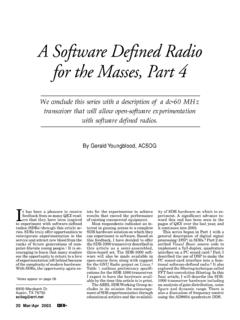Transcription of Sequential 4-bit Adder Design Report - ianhung
1 UNIVERSITY OF WATERLOO. Faculty of Engineering E&CE 438: Digital Integrated Circuits Sequential 4-bit Adder Design Report Prepared by: Ian Hung (iXXXXXX), 99 XXXXXX. Annette Lo (aXXXXXX), 99 XXXXXX. Pamela Torres (pXXXXXX), 99 XXXXXX. August 8, 2003. Table of Contents List of Figures .. iii List of Tables .. iv 1. Project Requirements .. 1. Functionality of Binary Adder .. 1. Design 2. Adder Architecture 2. Flip-flop Architecture Selection .. 6. Optimization Techniques .. 6. Sizing .. 6. Pre-layout Simulation 8. Layout of Sequential Four-Bit Adder .. 9. Post-layout Simulation Results.
2 10. 11. 12. Appendix .. A-1. ii List of Figures Figure 1: Sequential 4-bit Adder Layout .. 2. Figure 2: Complementary Static CMOS Full Adder .. 2. Figure 3: Pre-layout Simulation Response to Signal A and 8. Figure 4: Symmetrical Implementation of 1-bit Adder .. 9. Figure 5: Post-layout Simulation Response to Signal A and B .. 10. Figure A-1: Characterization of Setup Time (Pre-layout) .. A-1. Figure A-2: Characterization of Delay Time (Pre-layout).. A-1. Figure A-3: Characterization of Setup Time (Post-layout).. A-2. Figure A-4: Characterization of Delay Time (Post-layout).
3 A-2. Figure A-5: Test Bench for 4-bit A-3. Figure A-6: Schematic of 4-bit A-3. Figure A-7: Schematic of Transmission Gate Flip Flop .. A-4. Figure A-8: Schematic of 1-Bit A-4. Figure A-9: Schematic of AND A-5. Figure A-10: Schematic of Buffer .. A-5. Figure A-11: Schematic of Inverter .. A-6. Figure A-12: Layout of 1-bit A-6. Figure A-13: Layout of Flip Flop .. A-7. Figure A-14: Layout of AND Gate .. A-7. Figure A-15: Layout of A-8. Figure A-16: Layout of Inverter .. A-8. Figure A-17: Layout of 4-bit A-9. iii List of Tables Table 1: Truth Table for Full Adder .
4 1. Table 2: Comparison of Advantages and Disadvantages of Static Adders .. 3. Table 3: Design 4. Table 4: Comparison of Various Flip Flops .. 5. Table 5: Final Transistor Widths 7. iv Introduction The Adder is one of the most fundamental arithmetic operators used in the datapaths of microprocessors and signal processors. Since the Adder is usually the speed-limiting element within a datapath, its speed and power have drastic impacts on the overall performance of a system. Thus, the main goal of an integrated circuit designer is to optimize the Design of the Adder .
5 Circuit optimization includes manipulation of transistor sizes and circuit topology to maximize speed. Project Requirements The purpose of the project is to Design a Sequential 4-bit Adder , satisfying the requirements of performing successful additions of 4-bits within a clock period of less than 1000ps. Other constraints include the rise and fall times which are required to be equal to 100ps and the load capacitance which is required to be 20fF. The main objective is to maximize the figure of merit, which can be calculated using the following equation: Frequency(GHz ).
6 FOM =. Power ( W ). Functionality of Binary Adder Table 1 illustrates the basic operation of a binary Adder , where A and B are the Adder inputs, Ci is the carry input, S is the sum output, and Co is the carry out. Table 1: Truth Table for Full Adder [1]. A B Ci S Co 0 0 0 0 0. 0 0 1 1 0. 0 1 0 1 0. 0 1 1 0 1. 1 0 0 1 0. 1 0 1 0 1. 1 1 0 0 1. 1 1 1 1 1. The Boolean expressions for S and Co can be expressed as S = A Ci = AB'Ci' + A'BCi' + A'B'Ci + ABCi = ABCi + Co'(A + B + Ci). Co = AB + BCi + ACi Design Methodology The structure of the Sequential 4-bit Adder consists of a 1-bit full Adder , 5 flip-flops, and 1.
7 And gate. Figure 1 illustrates the general layout of the four bit Adder . 1. Figure 1: Sequential 4-bit Adder Layout Adder Architecture Selection The three main Adder designs considered include complementary static CMOS, mirror, and transmission gate based. Mainly static implementations are considered since dynamic circuits consume more power due to charging and discharging of load capacitors and the clock, and consequently result in a lower figure of merit. Moreover, since dynamic circuits are ratioless, optimization is more tedious since simple manipulation of NMOS and PMOS transistor sizes no effect.
8 Table 2 summarizes the advantages and disadvantages of the considered static designs. Based on the analysis above, it can be seen that the static Adder circuit basically translates the Boolean equations above into complementary CMOS circuitry, and the mirror and transmission gate based Adder Design requires less transistors than the complementary CMOS Adder . However, the mirror and transmission gate Adder designs were not attempted due to its complexity, as it incorporates multiplexers and/or XORs. And the complementary static CMOS Design was ultimately chosen due to its simplistic layout and its easily identifiable data transmission path.
9 Figure 2 depicts the chosen Adder Design . Figure 2: Complementary Static CMOS Full Adder 2. Table 2: Comparison of Advantages and Disadvantages of Static Adders [1]. Adder Types Advantages Disadvantages Logic effort reduced to 2 due Tall PMOS transistors stacks to carry generation circuit present in both S and C. Design on the smaller PMOS circuits stack Intrinsic load capacitance of NMOS and PMOS Co large and consists of two transistors connected to CI diffusion, six gate, and Complementary placed close to the output of wiring capacitances Static CMOS the gate, causing Extra delay due to two capacitances of internal inverting stages in the carry- nodes in transistor chain to generation circuit be pre/discharged in Sum generation requires one advance.
10 Extra unimportant logic stage Moderate number of transistors (28). Few number of transistors Boolean expression of S and (24) Co more difficult to identify NMOS and PMOS chains in circuitry completely symmetric, Capacitances include two resulting in maximum of two internal gate, and six gate series transistors in the carry- capacitances in connecting Mirror generation circuit and logic Adder , and the most critical effort of 2 at each input issue is minimizing the Transistors connected to Ci capacitance at node Co'. placed closest to output of Requires an additional gate inverter to recover the value of S, increasing the number of transistors to 26.






